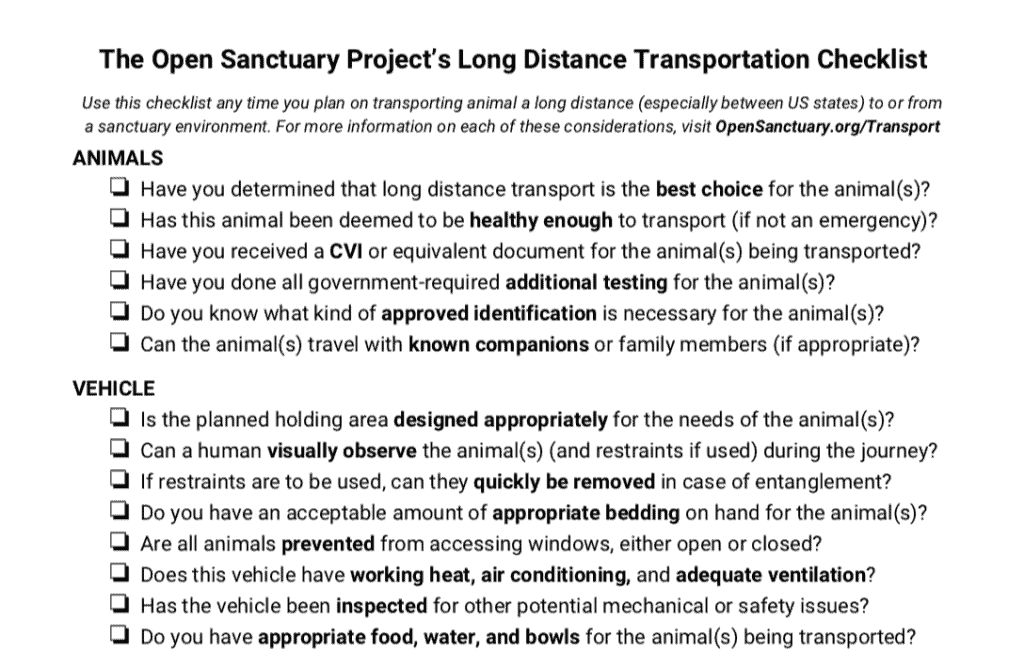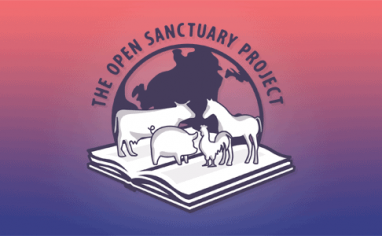
Enter your organization’s (or your) name and email below to download a free printable checklist to help plan for long distance animal transportation (especially interstate transportation within the United States). Reviewing this checklist, or one developed more specifically for your organization’s needs, should be a standard part of your sanctuary’s transportation operations.
Check out our full resource about long distance animal transportation to or from an animal sanctuary here!
And for a free printable form to help you log all necessary regulatory, veterinary, and welfare information during a transportation event, download our free transportation report form here!
We promise not to use your email for any marketing purposes! Would you prefer to access this form in a different way? Contact us and let us know!
Have you used this form at your sanctuary and want to give us your feedback on improvements? Let us know here!
Full Text Of This Resource
The Open Sanctuary Project’s Long Distance Transportation Checklist
Use this checklist any time you plan on transporting animal a long distance (especially between US states) to or from
a sanctuary environment. For more information on each of these considerations, visit OpenSanctuary.org/Transport
ANIMALS
- Have you determined that long distance transport is the best choice for the animal(s)?
- Has this animal been deemed to be healthy enough to transport (if not an emergency)?
- Have you received a CVI or equivalent document for the animal(s) being transported?
- Have you done all government-required additional testing for the animal(s)?
- Do you know what kind of approved identification is necessary for the animal(s)?
- Can the animal(s) travel with known companions or family members (if appropriate)?
VEHICLE
- Is the planned holding area designed appropriately for the needs of the animal(s)?
- Can a human visually observe the animal(s) (and restraints if used) during the journey?
- If restraints are to be used, can they quickly be removed in case of entanglement?
- Do you have an acceptable amount of appropriate bedding on hand for the animal(s)?
- Are all animals prevented from accessing windows, either open or closed?
- Does this vehicle have working heat, air conditioning, and adequate ventilation?
- Has the vehicle been inspected for other potential mechanical or safety issues?
- Do you have appropriate food, water, and bowls for the animal(s) being transported?
PLANNING
- Do you have a mapped out route for the journey, taking into account stops for breaks?
- Does your trip planning include a safe amount of rest and sleep for the driver(s)?
- Does your trip timing intentionally avoid uncomfortably hot or cold weather conditions?
- Does the route take into account seasonal challenges like road closures due to weather?
- Is the trip planned to occur while the CVI and all required permits are still valid?
- For longer trips, do you have two humans available to trade driving shifts for safety?
- Are you aware of any quarantineThe policy or space in which an individual is separately housed away from others as a preventative measure to protect other residents from potentially contagious health conditions, such as in the case of new residents or residents who may have been exposed to certain diseases. areas along the route that must be avoided?
- Do you have a plan and supplies in case the vehicle breaks down along the route?
- Do you have the resources on hand in case the trip takes much longer than planned?
- Do you have a plan and adequate supplies if you need to turn back during the trip?
- Do you have a plan if animals get injured, ill, or hostile with one another during the trip?
- Do you have a care expert or veterinarian aware of the journey and available for calls?
REGULATORY
- Have you called the destination’s government to learn of any additional requirements?
- Do you have the contact information for the destination government in case of issues?
- Have you received all required permits or paid required fees for animal transportation?
- Do you have all the paperwork necessary (with backups) available in one place?








